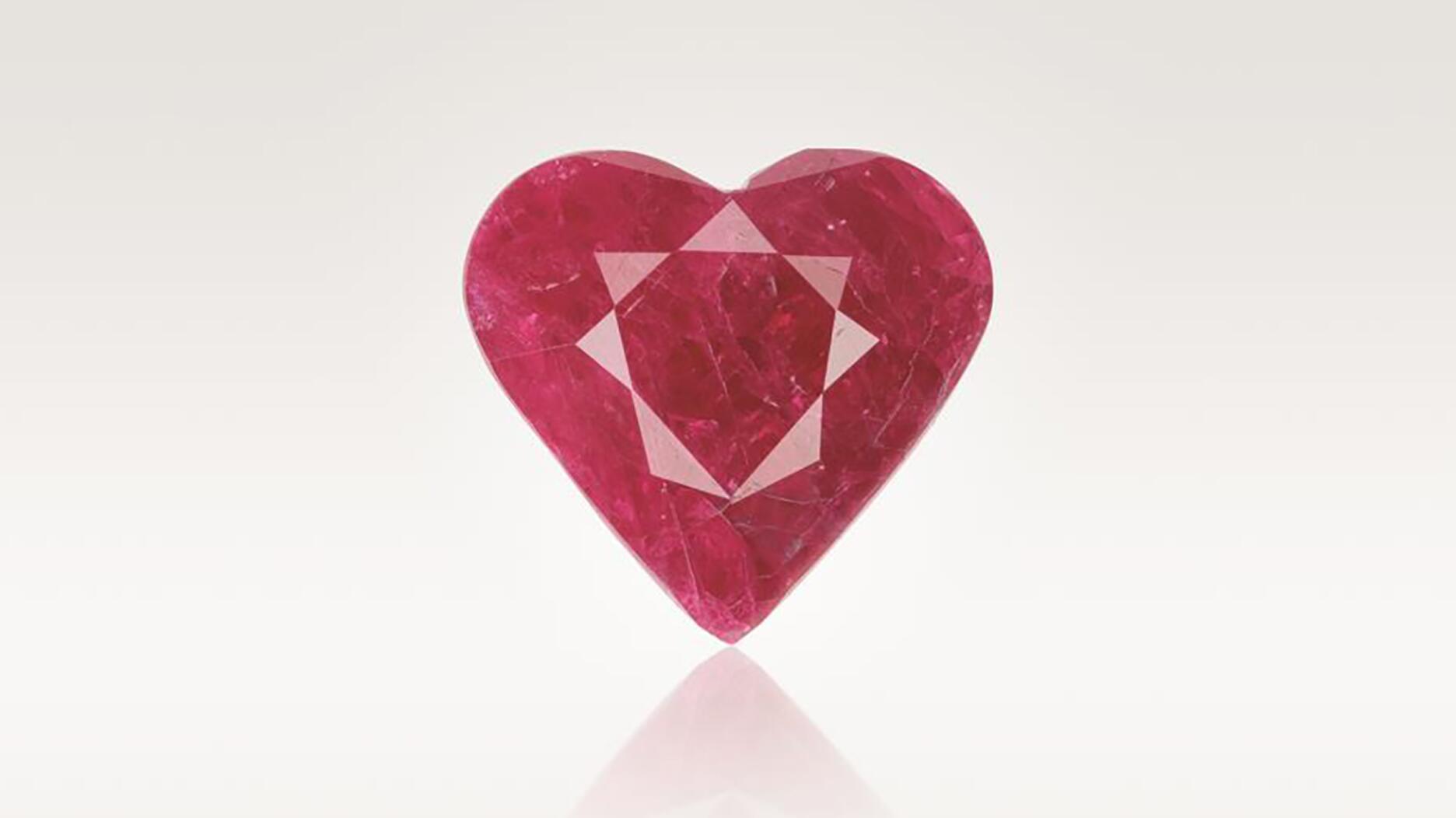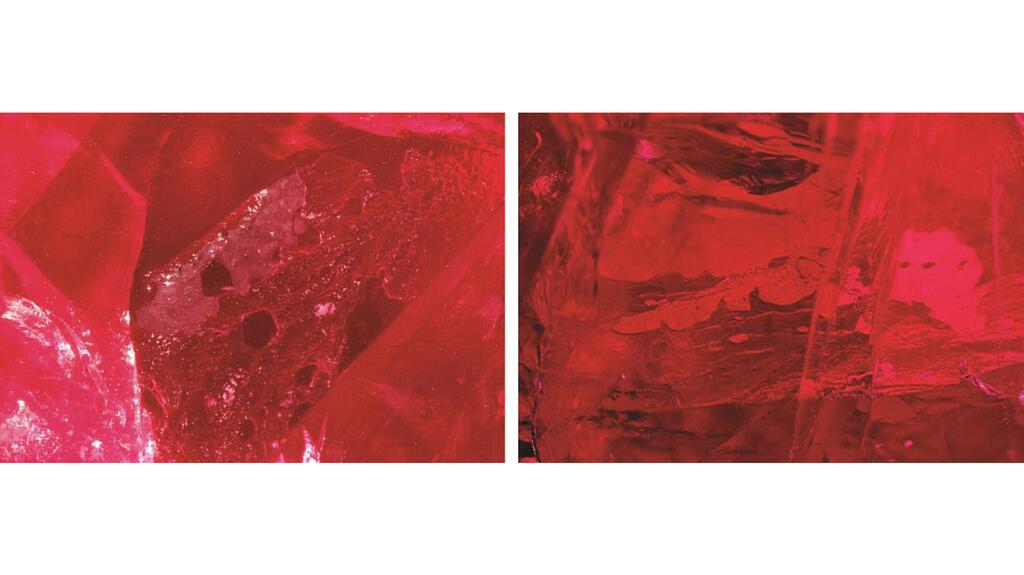GIA Examines Ruby Filled With Zinc Glass

This 8.57-carat heart-shaped ruby, submitted to GIA for identification, was discovered to have a zinc glass filling, a treatment never before seen by the lab. (Photo credit: Adriana Robinson)
"Carlsbad, Calif.—The Gemological Institute of America’s Carlsbad laboratory recently evaluated an 8-carat ruby filled with zinc glass.
The research appeared in a lab note in the fall 2023 edition of GIA’s quarterly professional journal “Gems & Gemology,” authored by Shiva Sohrabi and Amy Cooper.
While lead glass filling is a common treatment for rubies, seen even in a lab-grown stone, this instance was the first time graders at the lab have encountered a zinc glass filling.
According to the lab note in Gems & Gemology, the 8.57-carat heart-shaped ruby originally was submitted to the lab for identification.
GIA performed standard gemological tests on the stone and found that it showed properties of a ruby, including a refractive index of 1.760–1.769, medium to strong red fluorescence to long-wave UV radiation, and a very weak red fluorescence to short-wave UV radiation.
A ruby spectrum was obtained with a handheld spectroscope.
However, fiber-optic lighting showed several fractures in the gemstone containing a whitish filler and air pockets.
Using reflected light, analysts further observed that the fractures had a lower luster than the ruby’s host mineral, corundum, confirming the presence of some kind of filling material, the lab note said.

These images show the ruby fracture with whitish filler (left) and trapped air pockets (right). (Photomicrographs by Shiva Sohrabi; fields of view 1.58 mm, left, and 2.90 mm, right)
While the undetermined filler had visual properties similar to those of other glass fillers in corundum, GIA said it did not show the “blue flash effect” typically observed in rubies filled with lead glass, a characteristic noted in the article “Identification and durability of lead glass-filled rubies” from the spring 2006 edition of Gems & Gemology.
To determine the nature of the filler, graders performed a basic chemical analysis via energy-dispersive X-ray fluorescence spectroscopy (EDXRF).
“If there was lead in [the stone], which is what they suspected to start with, it’s easily detectable by that method,” Shane McClure, GIA’s global director of colored stones services, explained to National Jeweler.
The test did not reveal lead or bismuth, but instead, detected chromium, iron, and zinc, which McClure said was “something of an anomaly.”
A more sophisticated analysis, laser ablation–inductively coupled plasma–mass spectrometry (LA-ICP-MS), was performed as well. This technology uses a spot from a laser to gather a tiny amount of material for analysis via mass spectrometer, a test that McClure said is more accurate and can identify more elements.
It revealed the filler seen in the stone was a silica-based glass doped with zinc.
“Zinc had not been documented, as far as we know, as an element in one of these glasses they use to fill rubies,” said McClure.
Glass filling treatment has been used to increase durability and clarity of heavily fractured rubies since the 1980s, with cavity filling noted and described as early as 1984.
While lead glass fillers are the most popular filler for rubies, bismuth and cobalt have also been used, as noted in the spring 2020 edition of Gems & Gemology.
The original filler, silica glass, while quite durable, was easily visible due to its refractive index of about 1.5, which is significantly lower than corundum, an observation cited in a Winter 1984 edition of Gems & Gemology.
On the other hand, lead glass filler, discovered in early 2004, had a higher reflective index, about 1.70, and therefore offered better clarity enhancement.
However, the lead glass was not as durable as its silica-based predecessor and was subject to damage by even the standard retipping of a prong.
McClure said compared with lead glass from the 2000s, which contained about 70 percent lead, today’s lead glass often features more of the durable silica.
The filler seen in the heart-shaped stone, a silica-based glass with zinc as the main addition, appeared to improve the stone’s durability, but not its clarity, the lab note said.
“Normally, the purpose is to improve both clarity and durability,” McClure said. “In this particular case, [the filler] wasn’t doing much to improve the clarity for whatever reason. It could’ve been poorly filled or damaged subsequently. There’s a number of reasons that might be the case.”
One thing not mentioned in the lab note is that while zinc glass might be new to the world of gemstone fillers, it isn’t an entirely new concept.
“In the lead glass that most people are used to—which we call crystal and use for glassware and have for a long time—one of the alternatives to lead is zinc,” McClure said. “They make a glass with zinc in it that raises the optical properties of the glass just like lead does.”
One of the main reasons alternatives were sought for crystal is due mostly to the widespread consumer concern around lead.
In general, though, lead glasses are not something to worry about, McClure said.
“When [lead] is in a glass, it’s caught up in the molecular structure of the glass, and so handling it doesn’t do anything. Even drinking something out of it doesn’t do anything,” he said. “It’s not dangerous in normal events. Wearing it in a piece [of jewelry] is not dangerous.
“Nonetheless, the public is afraid of these things.”
GIA adds a comment on gemstone reports when lead glass is present, noting that care needs to be taken when doing work on the stone because of potential damage.
McClure speculates that, because of the general fear around lead, sellers would rather not have the comment if it can be helped, and this could be inspiring an exploration of new metals, like zinc, in these glass fillers.
“We see fillers with less lead than we used to, and we see fillers with bismuth rather than lead, which accomplishes a similar thing—raises the reflective index of the glass, making it a better filling material for corundum,” McClure said.
“I’d venture to ... "
https://nationaljeweler.com/articles/12 ... zinc-glass